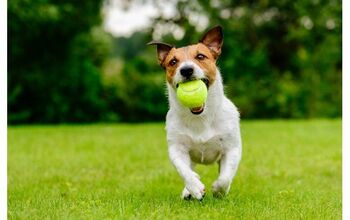Pee Problems: A Pro Shares How to Housetrain Any Dog

As a dog trainer working with mainly apartment-dwelling clients, housetraining is an important, sometimes messy topic. Many people adopt a dog or puppy, or get one from a breeder, with the assurance that the dog is housetrained. But minutes after bringing their bundle of joy home, Rover starts leaving housewarming presents on their oriental rug.
While the rescue group or breeder may not have intentionally been lying, owners often feel frustrated and ill-prepared to deal with frequent accidents. The fact is that a dog might be house trained in one environment, such as the foster home, but if he hasn’t been exposed to other homes, he may not realize the rules apply to all indoor areas. Further complicating matters is that people have different opinions about what housetraining is: for some, it means installing a doggie door, others allow dogs to use a pad to go potty indoors, and still others will claim a dog is housetrained even if he has occasional accidents indoors. None of these may fit your definition. To me, “housetrained” means that a dog knows with certainty where to go potty, whether it’s on a pad or outside, and will go there every single time he has to “go.” I don’t trust a dog is housetrained until he’s gone at least three months with zero accidents. If you live in a climate with changeable weather, I would get through every kind of weather — extreme cold and snow, heat, rain — before giving your pup his diploma in housetraining. That could easily take six months!
Keep in mind housetraining is not easy for many dogs. Growing puppies have questionable self-control in many areas but especially bladder control. And older dogs may have come from an environment where the rules were different or nonexistent. Learning takes time, patience, and consistency. Follow these steps to ensure you’re setting your dog up for a successful housetraining routine.
If at first you don’t succeed….
Take your dog to his potty spot as often as possible, whether it’s outside or on a pad. Sure, this means that sometimes he will not go potty when you take him there, but keep trying throughout the day until he pees or poops in the right spot. For puppies learning to go potty outside, this could mean going out every 30-60 minutes, as well as right after they’ve done anything (woken up, eaten, played for five minutes, etc.). Adult dogs can hold it for longer, but you still should give them tons of opportunities to go potty in the right place. The more bathroom breaks you take in the beginning, the smoother and faster your housetraining will go.
When in doubt, confine
In the beginning, your un-housetrained dog should either be actively supervised or safely confined in a place where an accident won’t occur. If you have to leave the room your dog is in, plan to take him with you or enclose him in a safe place. For a puppy, this likely means an exercise pen with a pee pad protecting the floor. Puppies should not be expected to hold it, especially if they have just woken up or engaged in an activity. For an older dog, a crate works well, as dogs prefer not to eliminate where they sleep. You can also keep your dog on leash or even carry a small dog to ensure he doesn’t sneak off to pee in your closet when you turn your back. All of these options are short-term techniques, intended for times you can’t keep an eye on your dog. If you have a safe, enclosed outdoor area, you can also give your dog extra potty breaks outside when you can’t watch him.
Potty time = Party time!
When your dog goes potty in the right place, celebrate with cheers and treats as soon as he’s finished. (Cheering while he’s doing his business can startle him.) This will make a positive association with doing his business in that place. On the flip side, since you will always be supervising your dog while inside (and confining him if he can’t be supervised), you’ll be there to catch an accident. While he is having the accident, try to interrupt him with a quick clap and then whisk him to his potty place. If he goes potty in the right place (which may not happen), cheer and reward. Remember to clean accidents thoroughly with an enzymatic cleaner.
Earning freedom
After a full month of accident-free living, you can slowly give your dog a little freedom, such as allowing him five minutes of unsupervised, unconfined time in the living room. With each passing month of no accidents, give him one more level of freedom, giving your dog access to more rooms for longer durations without being supervised. If your dog has an unsupervised accident, it probably means he’s been given too much freedom too fast. Go back to the previous level of freedom for a solid month.

Kate Naito, CPDT-KA, is a dog trainer at Doggie Academy in Brooklyn, NY, and author of the training book, "BKLN Manners." She draws upon her experience as an educator and dog trainer to apply positive training techniques to a challenging urban environment. Kate is a rescue advocate drawn to special-needs dogs and currently has two Chihuahua mixes, Batman and Beans.
More by Kate Naito























